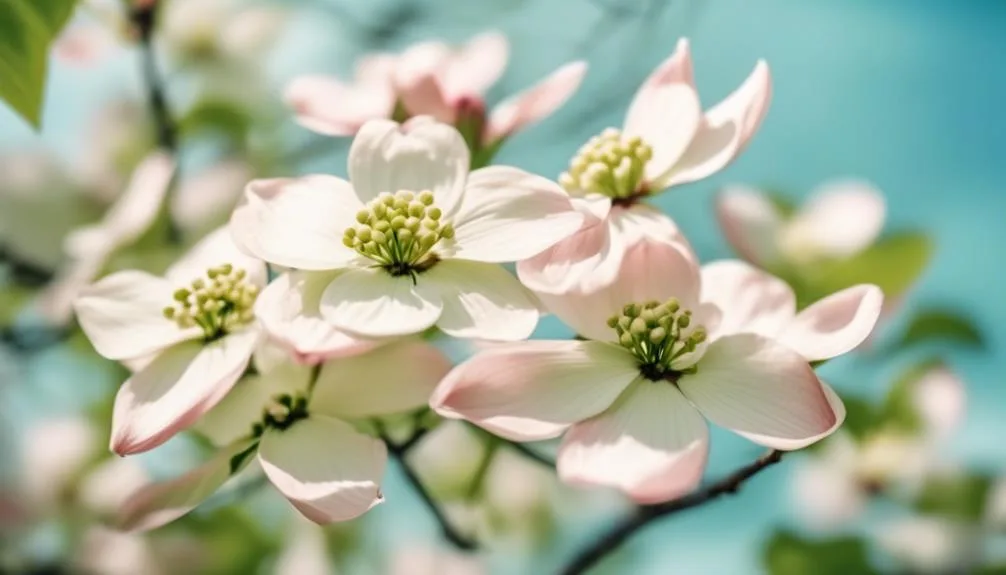In spring, dogwood trees display beautiful creamy-white blossoms resembling clusters of stars. The reason lies in nature's intricate design and the tree's unique traits.
Ever wondered why? What motivates these captivating blooms?
Let's explore the fascinating reasons behind this botanical spectacle.
Dogwood Tree Characteristics
If you're looking for a stunning addition to your landscape, the dogwood tree boasts a graceful, spreading canopy and showy spring flowers that will surely captivate your attention.
The flowering patterns of the dogwood tree are a sight to behold, with clusters of vibrant blooms that range from white to pink, creating a picturesque display.
The seasonal aesthetics are particularly enchanting as the tree transitions through the seasons, showcasing its delicate blossoms in spring and later developing attractive berries in the fall.
The dogwood's distinctive appearance adds a touch of elegance to any garden or yard, making it a popular choice for nature enthusiasts.
Its unique flowering patterns and seasonal aesthetics make it a standout choice for those seeking natural beauty and charm in their outdoor spaces.
Pollination and Reproduction
The dogwood tree's captivating flowering patterns and vibrant blooms play a crucial role in its pollination and reproduction, contributing to its unique charm and natural beauty. Here's how the pollination process and reproductive strategies work for dogwood trees:
- Specialized Pollination: Dogwood flowers have evolved to attract specific pollinators, such as bees and butterflies, through their striking colors and sweet scents. This specialization increases the chances of successful pollination.
- Cross-Pollination: Dogwood trees have developed strategies to promote cross-pollination, enhancing genetic diversity within the species. This is achieved through the separation of male and female reproductive parts within individual flowers, encouraging pollen from one tree to fertilize flowers on another.
- Seed Dispersal: Once pollinated, the dogwood's distinctive fruits serve as a means of seed dispersal, often attracting birds that consume the fruits and spread the seeds to new locations.
Attracting Pollinators
To attract pollinators to the dogwood tree, consider planting it in a location that receives ample sunlight and is sheltered from strong winds, providing an inviting environment for bees, butterflies, and other beneficial insects. The floral displays of dogwood trees are particularly attractive to pollinators due to their vibrant colors and sweet scent.
Bees are especially drawn to the nectar-rich blossoms, while butterflies are enticed by the broad, flat landing platforms that dogwood flowers provide. Understanding pollinator behavior is crucial in creating an environment that's conducive to successful pollination.
Dogwood trees bloom at a time when many pollinators are actively foraging, increasing the likelihood of successful pollination. By strategically planting dogwood trees and nurturing their floral displays, you can effectively attract and support pollinators in your garden or landscape.
Evolutionary Advantage
With their showy spring flowers and strategic bloom timing, dogwood trees have evolved to attract and support a diverse array of pollinators, ensuring successful pollination and propagation. This evolutionary advantage has allowed dogwood trees to thrive in various ecosystems.
The following factors contribute to the evolutionary advantage of their floral display:
- Adaptation to Ecosystems: The showy spring flowers of dogwood trees have evolved to match the specific pollinators present in their respective ecosystems, increasing the likelihood of successful pollination.
- Competitive Edge: Dogwood trees gain a competitive edge by attracting a wide range of pollinators, increasing the chances of successful reproduction and genetic diversity within the species.
- Species Survival: The evolutionary advantage of showy spring flowers ensures the continued survival of dogwood trees by enhancing their ability to reproduce and spread to new areas.
Environmental Adaptations
Adapting to their surroundings, dogwood trees have developed remarkable environmental adaptations to ensure their continued success in diverse ecosystems. One of their key adaptations is their showy spring flowers, which serve as a survival strategy. The vibrant flowers attract pollinators such as bees and butterflies, aiding in the tree's reproduction. Additionally, the timing of their flowering coincides with the emergence of these pollinators, increasing the chances of successful pollination.
Moreover, the flowers' visual appeal also plays a role in deterring herbivores, as the bright colors can signal the presence of potentially toxic compounds. Dogwood trees have also adapted to various soil types and can thrive in both shady and sunny conditions, allowing them to establish themselves in a wide range of environments.
These environmental adaptations have contributed to the dogwood's widespread distribution and ecological success.
Conclusion
The dogwood tree's showy spring flowers serve a vital purpose in its reproduction and survival. They attract pollinators and ensure successful pollination. This remarkable adaptation reflects nature's intricate and beneficial interconnections. It also highlights the beauty and functionality of the natural world.
How many other marvels of nature remain waiting to be discovered?

My interest in trees started when I first saw the giant sequoias in Yosemite.
I was a teenager then, and I remember thinking, “I need to learn more about this.”
That moment stuck with me.
A few years later, I went on to study forestry at Michigan Tech.
Since graduating, I’ve worked in a mix of hands-on tree care and community education.
I’ve spent over ten years helping people understand how to plant, maintain, and protect the trees in their neighborhoods.
I don’t see trees as just part of the landscape.
They are living things that make a real difference in our daily lives.
